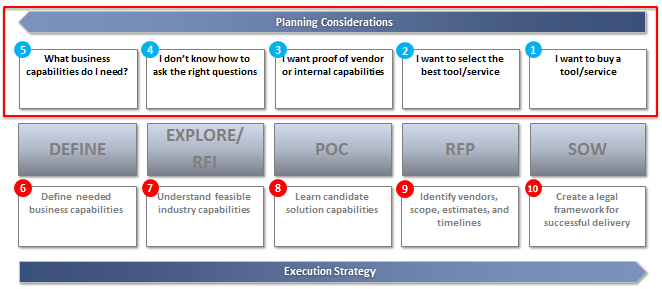Insight Paper January 13, 2015
Strategic Vendor Selection
Key Elements of Pre-Planning
Key Elements of Pre-Planning
Enterprises both large and small often depend on vendors to support their core businesses even though the vendor selection processes are consistently tortuous and disjointed. Initiatives involving vendor selection will kick off and almost immediately struggle to maintain structure and focus, resulting in more confusion leading to poor staff utilization, missed schedules, and over or under-spends, etc. In order to be more successful, businesses should adopt a slightly modified approach to typical vendor selection, focusing on pre-planning and finalizing end results in each step of their selection process.
The industry-standard selection process is depicted below:

This process is certainly logical as it progresses from step to step. However, through our extensive experience in RFPs, RFIs, and POCs, we’ve realized starting with the ‘Define’ stage is simply no longer early enough; nor does it provide a strong enough foundation for a truly successful vendor selection process. There are a number of steps prior to “Define” which we find necessary in order to ensure business engagement, commitment, and understanding. These pre-steps are described below:

Steps 1-5’s objectives are to focus the business and technology stakeholders on the precise questions, capabilities, and ultimate requirements leading to a successful vendor selection.
- The new Step 1 is the true beginning of vendor selection as the business has expressed its willingness and desire to improve via a tool/service in order to accomplish their goals. Only once this ‘call-to-arms’ is issued, the vendor selection process can truly begin.
- Step 2 is accomplished by the business and IT in cooperation. While the term ”best” may not be the highest cost, or the latest technology, or the most features, this step is about reaching agreement on what ‘best tool’ means for the business (including unintended side effects and total costs).
- Step 3 Once the business has articulated its requirements in terms of ‘best for the business,’ research can begin to verify internal and external capabilities in this space.
- Step 4 is a brainstorming session following the research in Step 3. With the knowledge of what is available in industry and capabilities internal to the enterprise, this step generates the initial list of questions which will need to be answered through the process. This list will be finalized in Step 7, the exploratory and RFI stage.
- Step 5 finalizes the groundwork for the industry-standard execution stages (now Steps 6-10). In this step, business interviews are conducted to define which business capabilities will need to immediately be addressed.
Working hand in hand, the Planning Stages of Steps 1-5 are essential to successfully carrying out Steps 6-10 of a vendor selection. Not only is business engaged through the entire process, but proper thought and strategy helps align the effort into existing client vendor processes making for smoother transitions and implementations.

